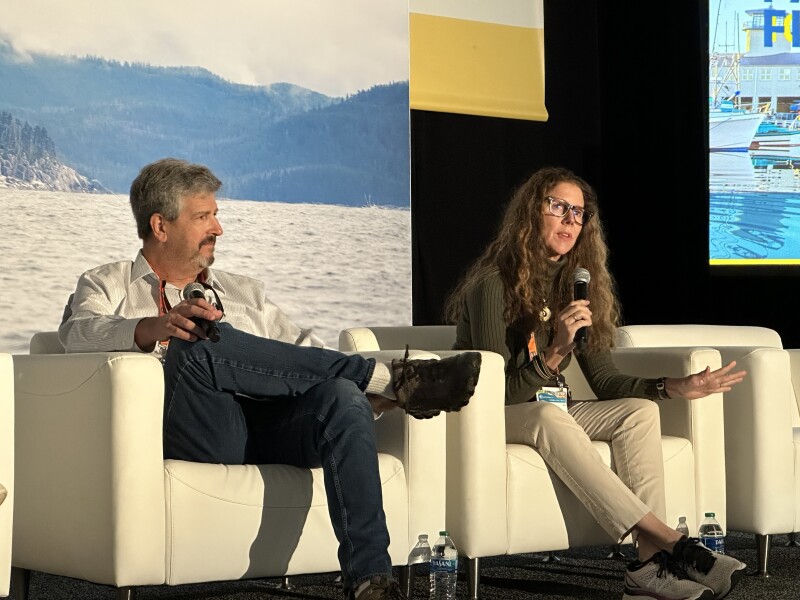The drive to develop U.S. offshore wind industry is growing along the West Coast, and fishermen should pay close attention to the political and legal battles already ongoing in the Atlantic states, a panel of experienced activists said at the Pacific Marine Expo Thursday in Seattle.
“I’ve been fighting offshore wind since 2003,” said Bonnie Brady, executive director of the Long Island Commercial Fishing Association. In those early years, the first proposed projects “died because of the cost,” she said.
Today, “there are a multitude of projects going on,” Brady said, as a screen flashed map graphics showing about 30 proposed wind turbine developments from the Gulf of Maine to the Carolinas, and now more off California and Oregon.
California fishermen were later observers to what is now a concerted push by federal and state governments, but now they too are alarmed, said Jeremiah O’Brien, vice president of the Morro Bay Commercial Fishermen’s Association.
“In 2015 we were watching what Bonnie and all the folks on the East Coast were dealing with and didn’t like what we saw,” said O’Brien. Eight years later, wind power developers “still believe mitigation will not be necessary” to compensate fishermen for the loss of fishing grounds when turbine arrays are built, he said.
“We’re not against wind power. We are against the areas where wind power is being proposed,” said O’Brien. The floating wind turbines envisioned for deepwater Pacific sites would make it impossible to fish amid the arrays and their anchoring cables, potentially affecting 4,500 square miles of ocean that “will cripple individual ports,” he said.
Six Northeast states are heavily committed to offshore wind – so much that their governors asked President Biden in September to boost tax credits and other incentives to help keep offshore wind developers from backing out of their existing power purchase agreements with the states. On the West Coast, state policies still vary at this point, said Mike Conroy of West Coast Fisheries Consultants.
“California is all in, without knowing what offshore wind is about,” said Conroy, who is working with the Responsible Offshore Development Alliance, a coalition of U.S. fishing groups and communities affected by offshore wind proposals. Oregon officials are taking a more measured approach, asking the federal Bureau of Ocean Energy Management to take more time as it reviews wind energy areas in Northwest waters, he said.
Washington State has yet to make firm commitments. But Gov. Jay Inslee was recently in Seattle, talking up the potential for West Coast wind power to bring new business to the state’s maritime industry, Conroy noted.

Brady and Conroy urged West Coast fishermen to pay close attention to developments and to organize now to protect their future.
“Nothing about this process is open, which is why we’re suing,” said Brady, whose New York association joined Rhode Island squid processor Seafreeze Ltd., represented by the Texas Public Policy Foundation, in a lawsuit challenger offshore wind projects off southern New England.
That lawsuit is awaiting action in a federal appeals court. The fishermen’s appeal has drawn criticism from environmental advocates, who point to the Texas Public Policy Foundation’s donor ties with fossil fuel interests. But fishing advocates make no apology for allies in what they see as an existential struggle.
“We’re in the fight of our lives,” said Brady. “We don’t have any other choice; we fight or we die.”
“I think litigation on the West Coast is inevitable,” said Conroy. West Coast fishing advocates can study the earlier East Coast lawsuits and court rulings to learn what could work for them, he added: “It will help to better know the cases and the issues.”
Likewise, there are lessons to be drawn from how local groups in New England and the Mid-Atlantic are fighting offshore wind power proposals off their costs, said Brady. She has worked closely with activist groups in New Jersey beach communities like Ocean City, Brigantine, and Long Beach Island, which swung into action in December 2022 when the first in a series of dead humpback whales washed up on beaches.
“Nothing was more of a lightning strike to New Jersey than to get 13 dead whales,” appearing over the space of a few months, said Brady, and a tally of 78 humpbacks from Maine to Florida.
The groups attempted to tie the strandings to survey vessels working on wind energy sites during those months, questioning if acoustic soundings disturbed and disoriented the mammals and caused the strandings.
Officials with BOEM and the National Oceanic and Atmospheric Administration denied any connection. But scientific literature shows there is no direct data on how sounds may affect baleen whales like humpbacks, said Brady.
“The bottom line is they’re guessing,” she insisted.
“You also need to get to know your communities” and reach out to tourism businesses, local chambers of commerce, and others to get them involved on offshore wind, Brady told fishermen. Plus, she added, now is the time “to start building a war chest” for going to court.
“I think Mike is right; unfortunately, litigation is where this is going to end up,” said O’Brien. “We’re fighting the biggest corporations in the world and our own government.”







